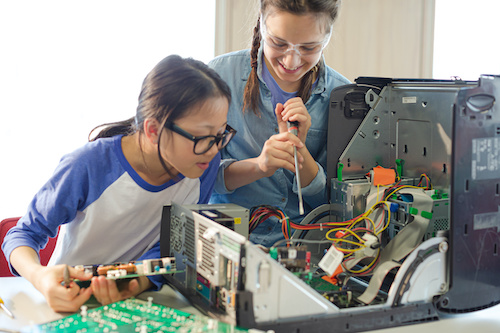Key points:
All too often, female students are underrepresented in STEM classes. As a result, girls and young women have a hard time exploring the subjects and picturing themselves in related roles. Some progress has been made–for example, the number of women earning science and engineering bachelor’s degrees increased by 34 percent between 2011 and 2020–yet there’s still much ground to be made up. Today, math scores are at pre-pandemic lows (thanks in part to years of remote learning) and elementary-aged children are falling behind grade-level standards, posing significant risks to children’s educational development. This situation widens disparities in education and drives a shortage of incoming STEM talent as these trends carry into university and ultimately career paths.
According to a recent McKinsey study, 87 percent of companies are aware that they either already have a skills gap or will have one within the next five years. As technology continues to advance at a rapid pace, the need to address this gap is becoming vital. Combatting this challenge relies on revitalizing the passion for STEM learning in young students, especially females, as the future of the workforce hinges on the next generation’s ability to meet the technological needs of tomorrow. ePlus and Cisco are leading the way with Girls Re-Imagining Tomorrow (GRIT)®, a hands-on, STEM-based program focused on introducing diverse groups of middle and high school girls to technology-focused career possibilities.
When approaching STEM education, it’s important to take actions that help bridge the IT skills gap and cultivate a diverse, inclusive workforce equipped to drive future IT solutions and cybersecurity.
Addressing the skills gap through empowerment
Lower math scores can hinder students’ ability to grasp foundational concepts essential for more advanced STEM subjects. Consequently, students who face difficulties in meeting academic standards might find themselves lacking the requisite skills and knowledge to effectively pursue careers in IT. This can exacerbate the disparity between the demand for IT professionals and the available workforce, leading to potential economic repercussions. To address this issue, ePlus is empowering girls by highlighting the various career opportunities available to them and equipping them with the necessary technical foundation to pursue these paths. For example, a GRIT education provides presentations by technology leaders and innovators both in their community and more broadly, field trips to local ePlus and Cisco offices for a ‘behind the scenes’ experience, and demos and hands-on technical classes.
Closing the gender gap
Lower interest and abilities in technology can heighten the barriers that girls in STEM already face, including gender stereotypes, lack of representation, and unequal access to resources. These educational setbacks could further perpetuate the gender gap in an industry where women accounted for just 28 percent of the STEM workforce in 2023. To counteract this trend, initiatives like GRIT provide girls with invaluable mentorship from accomplished women in technical fields, demonstrating that they too can achieve success. Through these connections, GRIT instills in girls the same resilience and determination that have propelled women to success in their careers and lives.
Developing technical skills
The dynamic nature of today’s cybersecurity and IT landscape demands a constantly evolving educational approach to prepare young students effectively. Emphasizing hands-on learning is crucial in this evolution of STEM programs, as it enables girls to actively interact with technology, fostering a deeper understanding and genuine passion for innovation. As part of the GRIT program, girls have access to technical classes covering Artificial Intelligence & Machine Learning, Internet of Things, Cybersecurity, Coding & Robotics, and more, aiming to bolster their confidence in areas that may have initially seemed daunting or inaccessible. Through interactive and motivational sessions, GRIT makes STEM courses more meaningful and tangible, resulting in a more engaged classroom environment and a reignited enthusiasm for learning.
Providing a community-based learning environment
Successfully inspiring young women in STEM programs requires more than just teaching technical skills–it also requires cultivating a culture of community. By providing a network of peers and leaders, students can feel a sense of belonging and safety as they begin to think about their future goals. Fostering community learning goes beyond IT education; it is about establishing a supportive community for girls, accompanied by mentorship in areas such as public speaking, ethics, online safety, and overcoming impostor syndrome. This type of mentorship allows girls to openly share and discuss their experiences, empowering them to build confidence and create goals that can benefit them for the long-term. ePlus’ overarching aim is to empower young women by nurturing self-assurance and resilience, thereby facilitating success in both their professional endeavors and personal lives.
Empowering girls through STEM education is not just about teaching technology; it’s about fostering a mindset of curiosity, innovation, and leadership. STEM programs must prioritize creating inclusive and supportive environments where girls feel encouraged to explore, take risks, and dream big. By investing in the development of girls in STEM, we can pave the way for a more diverse, innovative, and equitable future in technology and inspire the female leaders of tomorrow.


